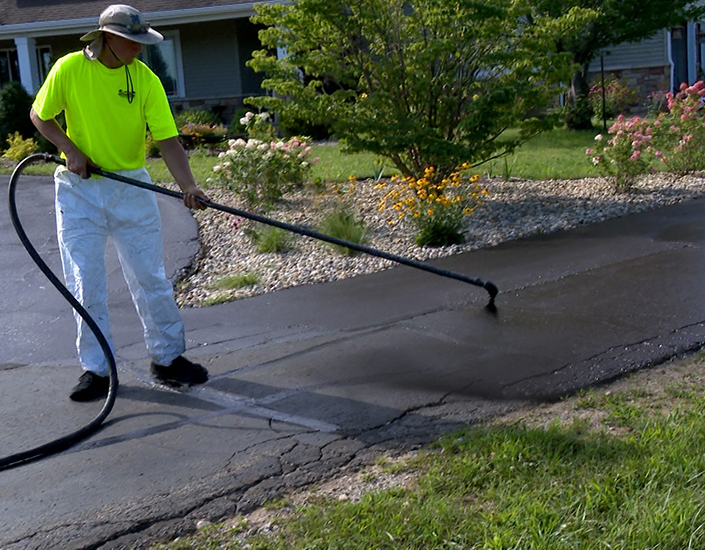Hot Mix Asphalt: A Lasting Option for Pavement
Hot Mix Asphalt (HMA) has arised as a leading sustainable option for pavement options, providing a myriad of innovative innovations and environmental benefits. As the need for green construction practices grows, exploring the nuances of HMA's sustainability can give valuable insights right into the future of pavement services.
Environmental Benefits of Warm Mix Asphalt

Furthermore, Hot Mix Asphalt helps to reduce city heat island effects. Its dark shade absorbs sunshine, reducing the quantity of warm reflected back right into the atmosphere contrasted to lighter-colored pavements. This can reduce ambient temperatures in urban areas, lowering the demand for air conditioning and inevitably decreasing power intake.
On top of that, Warm Mix Asphalt contributes to boosted stormwater management. Its permeable nature permits water to infiltrate the sidewalk and reenergize groundwater materials, minimizing runoff and the threat of flooding. These environmental benefits make Hot Mix Asphalt a sustainable selection for paving roads and freeways.
Power Performance in HMA Manufacturing
Is power efficiency a vital aspect in the production of Warm Mix Asphalt (HMA)? Energy plays a considerable role in the manufacturing of HMA, affecting both price and environmental sustainability. One essential facet of energy efficiency in HMA manufacturing is the use of warm mix asphalt (WMA) technologies.
In addition, advancements in plant technologies have brought about even more energy-efficient HMA manufacturing procedures. Modern plants are made with functions like recycled asphalt pavement (RAP) processing abilities, reliable burner systems, and improved insulation, all adding to power financial savings. By optimizing power use in HMA manufacturing, the industry can lower its carbon footprint while maintaining high-grade sidewalk materials. Energy effectiveness is, as a result, an important factor to consider in making sure the sustainability of Warm Mix Asphalt production.
Recyclability of Warm Mix Asphalt
The recyclability of Warm Mix Asphalt (HMA) is a crucial facet of its sustainability and long-lasting ecological impact. HMA is just one of the most recycled materials in the USA, with over 100 million tons of reclaimed asphalt sidewalk (RAP) being recycled annually in new sidewalk building and construction. Recycling HMA offers a number of ecological benefits, such as reducing the need for virgin products, decreasing power intake during production, and decreasing the amount of waste sent out to land fills.
The process of recycling HMA includes milling the existing sidewalk, squashing it into smaller sized pieces, and blending it with brand-new aggregate and asphalt binder to produce a recycled mix. This recycled mix can usually perform as well as and even better than conventional HMA, while needing less resources and generating lower greenhouse gas emissions. By integrating RAP right into new sidewalk projects, road firms Resources can conserve natural deposits, minimize expenses, and lessen the ecological footprint of road construction and maintenance activities. Overall, the recyclability of HMA plays a considerable duty in advertising sustainable techniques within the sidewalk industry.

Long-Term Performance of HMA
Asphalt pavements demonstrate resilience and resilience over an extended period, mirroring the long-term performance of Warm Mix Asphalt (HMA) Additionally, improvements in HMA modern technology, such as the use of polymer-modified binders and warm mix asphalt, have additionally enhanced the durability and durability of HMA pavements. By focusing on quality construction and upkeep techniques, HMA proceeds to verify itself as a affordable and lasting service for durable sidewalk framework.

HMA: Sturdiness and Sustainability
Showing both sturdiness and sustainability, Warm Mix Asphalt (HMA) has actually come to be a cornerstone in the building and construction of long-lasting sidewalk facilities - regrading. HMA's resilience comes from its ability to stand up to hefty loads, extreme weather, and high traffic quantities, making it a dependable selection for roads, highways, and airport terminal paths. The make-up of HMA, which commonly consists of aggregates, binder, and filler, plays a crucial duty in boosting its longevity and resistance to tear and put on
In addition, HMA's sustainability exists in its recyclability and energy-efficient manufacturing process. The ability to recycle reclaimed asphalt pavement (RAP) in new HMA mixes lowers the need for virgin products and reduces the environmental visit this site impact of pavement building and construction and maintenance. Additionally, the energy effectiveness of creating HMA hinges on its reduced blending temperatures compared to various other pavement materials, leading to decreased energy usage and greenhouse gas emissions.
Final Thought
In verdict, hot mix asphalt (HMA) provides a lasting solution for sidewalk with its eco pleasant features. HMA's recyclability, power effectiveness in production, and lasting longevity make it an eco-friendly option for roadway construction.
HMA is one of the most recycled materials in the United States, with useful source over 100 million heaps of recovered asphalt pavement (RAP) being recycled each year in new pavement construction.The process of recycling HMA involves grating the existing pavement, crushing it right into smaller sized pieces, and blending it with brand-new aggregate and asphalt binder to create a recycled mix.Asphalt sidewalks show toughness and strength over a prolonged duration, reflecting the lasting performance of Warm Mix Asphalt (HMA) Furthermore, innovations in HMA innovation, such as the usage of polymer-modified binders and warm mix asphalt, have even more enhanced the sturdiness and longevity of HMA sidewalks. The capacity to recycle recovered asphalt pavement (RAP) in brand-new HMA blends decreases the need for virgin products and reduces the environmental effect of sidewalk building and maintenance.